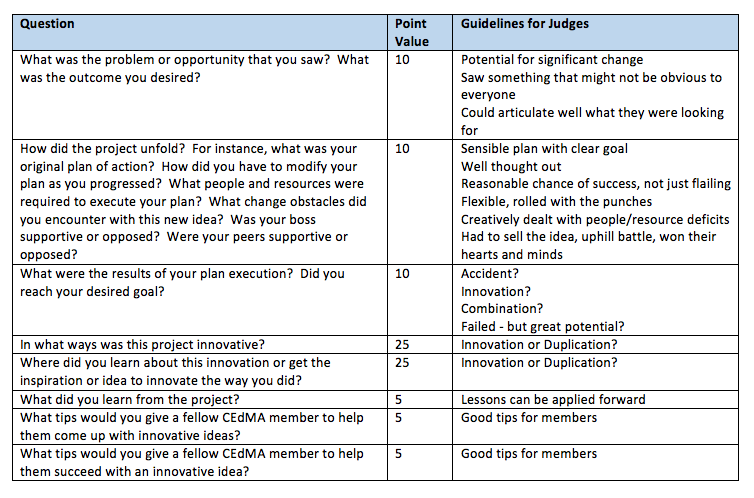
Do you know that CEdMA has two award cycles each year? The Impact Award is announced in the spring, and the Innovation Award in the fall. As a CEdMA Board member and one of the CEdMA judges I look forward to learning what our members are up to. However, it seems every submission I review has its own style and layout. Some submissions are attractive and appealing to read, while to be honest, others are a long boring slog. It occurred to me during the last award review cycle that CEdMA members and judges would both benefit by sharing the specifics of the judging criteria to help you create a winning entry.
This blog provides a peek inside the judges’ chamber to improve your chances of success. While the number of judges may vary, we all follow the same judging spreadsheet, which maps to the questions on the application. For the example below, I use the 2019 Innovation Award. The application contains several questions, aligned with categories to evaluate, each with an associated point value and then guidelines for judges.
Innovation Award Judging Spreadsheet
The Question column below shows the questions on the Innovation Award application form for you to answer. The two columns to the right are what the judges see on the judging spreadsheet. The Point Valuecolumn indicates where the emphasis should be in your application. The Guidelines for Judges column shows what the judges are looking for. In particular judges get excited when we see companies that are doing something unique and special. Though I use the Innovation Award as an example, the rules and guidelines are about the same for the Impact Award. The key differentiator for the Impact Award is that we really look for plenty of metrics and data to clearly demonstrate the impact on the business. If your Impact Award submission does not include the data, it won’t get very far.

Based on the criteria, and the judge’s ratings, a winner is chosen. Below are my tips to make your application stand out from the rest. Before you submit your entry, ask yourself if you want to read the submission. If you feel tired just thinking about reading it, then the judges will feel the same way.
Make it attractive
As a judge, I consider the look and feel of the submission before awarding any points. When I see spelling, formatting, or grammatical errors, or if the application does not suit the category, it’s hard to award maximum points. A sloppy application shows a lack of care and quality. Use the “show, don’t tell” approach when writing your application by including images, graphs, charts, and timelines, when appropriate. Regardless of the immense impact or innovation the quality of submission could determine a tie-breaker, so make your entry easy to read and visually pleasing. However, all ‘garnish and no meat’ doesn’t help, so make sure your application is substantial without going into overkill.
Clearly state the problem
Set the premise by clearly stating the problem. While one sentence cannot say it all, one page is too much detail. Depending on the situation, graphics and charts help to illustrate the situation, but don’t force them if they don’t belong. Portray the opportunity and the desired outcome to set the tone for the rest of the submission. When explaining the outcome, I look to see if it aligns with the premise, be it a problem or opportunity. I want to know details about the expected outcome. I look for the thought process behind the desired outcome, the drivers, a clear explanation of the expected results, and any supporting material. Also, there must be an impressive problem or opportunity that needed attention.
Plan of action
For the plan of action and the way it unfolded, a timeline is a great way to augment any description of the plan. Long text blocks are a challenge to wade through and comprehend. You could break up the plan into easily consumable sections with headings. Highlight how you coped with roadblocks, how mid-course adjustments were made, and how you achieved buy-in, if ever.
As you portray your results and goal achievement, be honest and forthright. If your project missed a goal, state why. If you achieved or exceeded your desired goal, show the journey and elaborate on the story. Give the judges the story behind the results, and find an innovative way to present them. Careful attention to detail and presentation of supportive evidence is crucial. Show how this is an innovation, and not a variation of something that has been done before. As judges, we see that all too often in applications. We really are looking for something original and creative. Your innovation is the meat of the application, so make it really shine. Emphasize your measurements and how it changed the business, if it did. If your creative approach was brilliant but didn’t have the impact you expected, let us know about it. The use of quotes from stakeholders or customers is an elegant touch. It is very important to include your key performance indicators (KPIs). The method you used for data collection can start with a simple statement, but should get much deeper. This is especially true for the Impact Award. You might indicate how you implemented the project in phases, and what you collected in each phase. Showing and contrasting the before and after states of the business also help.
Map the journey
The second major section is about the source, or inspiration, behind your innovation. This should not be a restatement of what has been said already. The high point value for this section indicates that we want to know what inspired you to innovate your business. Was it based on an idea from another CEdMA member, something you read in a publication, or was it a random flash of brilliance? Map the journey, or recount the state of business that led you to innovate, and how you brought the innovation to reality. While this is close to what the first question on the application asks, we want to see the backstory. This is your chance to earn major points, so be creative in the way you tell the story.
Lessons learned
This section should not be overlooked because challenges and mistakes can be an important part of the learning process. Perhaps you learned that one approach in your organization works better than another. Each lesson learned is a discovery worth sharing and helps you reinforce the gravity and depth of your innovation. As a judge, I look for the value offered to other members from your project. So, pick up “easy” points by recounting the lessons you learned. CEdMA is about sharing, and the more you offer as help for your fellow members, the better. I would list five great tips on how to forge innovative ideas. As a judge, I will likely award one point for each worthy tip. Your innovation doesn’t have to be based on something that originated from CEdMA to score points. But if it did, we would sure like to know about that. In addition, share how you will proceed now that your innovative idea is a reality. Another approach is to share what you would do differently if you executed the project again.
Tips for CEdMa members
These sections should be an easy ten points to obtain when done properly. This is your chance to educate CEdMA members, and show why your project is worth winning this award. Discuss how to go about driving innovation, including the methodology and any industry research you did. Close by telling fellow members how to succeed with innovative ideas. Innovation means change and we know not everyone is open to change. How did you overcome the naysayers, or the detractors, to make your project successful? How did you communicate progress, and build champions? These are just a few suggestions of the types of tips we are seeking.
Good luck!
The opinions expressed in this blog are my own. Many are also shared by my fellow judges. The CEdMA Board is excited to see quality applications coming our way and we wish you good luck with your projects and your submissions, whether they are award winning or not. We appreciate the time and effort you make in applying for the prestigious CEdMA Awards and the pride that exists behind the results. I hope that by revealing our judging criteria, you have a better idea of the expected outcomes, and the methods of evaluating the applications we receive.

